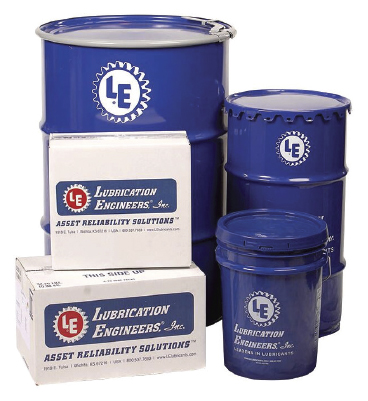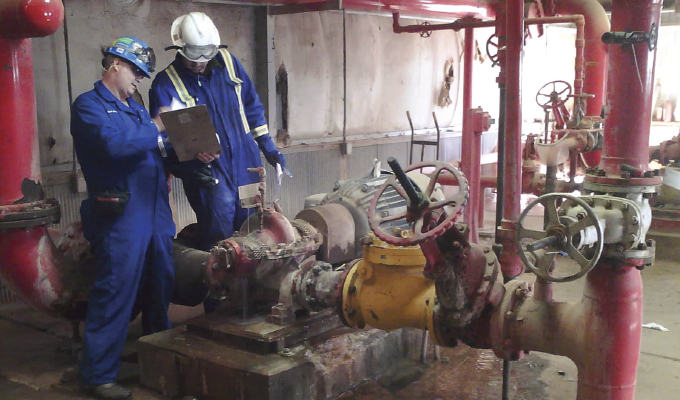Often companies consider lubricants to be commodity supplies and opt for lower cost products without stopping to think about what this means over the long term. For example, if a critical conveyor line bearing goes down, the cost of that bearing may be inexpensive ($50), but then they must pay $75 per hour to schedule repair, plus the cost of the lubricant, as well as the cost of downtime while the part is repaired.
Losses from a power plant not feeding coal due to a broken conveyor bearing may run up to half a million dollars a day. It may cost $200,000 or more per hour because they are not generating electrical output due to downtime. If a higher quality lubricant saves the bearing, the plant achieves a huge return on investment (ROI). Even though the price of lubricants makes up only 1 to 3 percent of the overall maintenance budget, facilities are saving by reducing reactive labor, replacement of parts, and unplanned downtime due to machinery unavailability.

PAIR LUBRICANTS WITH PREVENTIVE MAINTENANCE AND STAFF TRAINING
In addition to the use of quality lubrication products, the use of predictive or preventive maintenance plays a key role in optimizing lubrication efficiency. Strategies should be developed to predict when a piece of equipment is expected to fail, then schedule and plan maintenance on the asset to avoid that failure. Many industries are trending toward scheduling oil changes with predictive condition-based methods versus older time-based methods.
These strategies can be helped by a thorough evaluation of a facility’s lubrication program. For example, Lubrication Engineers offers its Xpert Lubrication Benchmark Audit, a one-day walkthrough that looks at a facility’s lubrication program and ranks it compared to industry standards and best practices. Audit categories include lubrication best practices, asset and lubricant identification, storage and handling, oil analysis and sampling, contamination control, filtration, training, skill development and certifications, software, CMMS and EAM, and safety and accessibility.
Also available is the Xpert Equipment Reliability Assessment, in which every rotating piece of equipment is evaluated with the goal of building reliability around critical assets. After review, the team prepares an agenda with a prioritized plan of action by priority to move the facility’s needle up to best practices and expected ROI.
Finally, education and technical support are critical. Facilities should ensure their staff is properly trained in lubrication fundamentals, so they can understand and respond to OEM lubrication recommendations and specifications. Training helps personnel understand what greases and oils are compatible and what is needed to make sure the equipment runs most efficiently. One example is Lubrication Engineers’ Xpert Lubrication Reliability Fundamentals (LRF) class, a convenient private onsite training option designed primarily for a facility’s maintenance and lube technicians to understand the core fundamentals of lubrication and contamination control.
SIGNIFICANT COST SAVINGS OR OPERATIONAL IMPROVEMENTS
Often budget is brought up as the reason higher quality lubricants are not used. In fact, in many cases, switching lubricants may lead to a reduced need for electrical energy or reduced temperature, yielding electricity savings. Here are a few real-life examples that showcase the excellent ROI achieved from investment in higher quality lubricants.
Example 1: Cooling Tower Gearboxes
In a 32-month analysis of cooling tower gearboxes used by Wolf Hollow Electrical Energy in Texas, Lubrication Engineers converted 14 gearbox drives to its Multilec® Industrial Oil (6806). Periodic electrical readings performed on the gear drives before and after the lubricant conversion showed an average amp drop of 9.38 amps, an average of 5.12 percent. Using a standard electrical formula (volts x amps saved x 1.73* = kW Savings *conversion factor for a 3-phase power source), they determined that every 1,000 hours run on the gearboxes will yield electrical energy savings of $223.92. This adds up to a 908 percent ROI, based on electrical energy and lubricant savings.
Example 2: Fleet Maintenance Program
Peak Oilfield Service Company, located on Prudhoe Bay, Alaska, partnered with Lubrication Engineers to evaluate the company’s fleet maintenance program with a goal of implementing a more proactive predictive maintenance program. The evaluation included benchmarking the current program to understand the overall cost per mile to operate the fleet.
Peak’s fleet is comprised of more than 2,000 pieces of equipment, including service trucks; dozers; wheel loaders; scrapers; cranes; pressure pumpers; haul, vacuum and water trucks; snow blowers; and diesel generators. Prior to its new reliability program, Peak performed all service truck engine oil changes every 200 hours, and all heavy-duty, off-road equipment engine oil changes every 300 hours. Repeated trials and evaluation of LE’s Monolec® Engine Oils showed that the new product extended drains out to 1,500+ hours while maintaining superior wear protection. In fact, some equipment had extended oil drains as far out as 2,200 hours, and oil analysis demonstrated that the Monolec Engine oil still maintained its viscosity and TBN while delivering outstanding wear protection in the engine.
Following consistent trial successes, Peak switched all its engines to LE’s Monolec Engine Oils, establishing 1,200-hour drain intervals for all mobile equipment. Within eighteen months, they had achieved 50 percent total savings in cost per run hour; 46 percent savings in engine oil usage costs; 67 percent savings in engine oil disposal costs; 76 percent savings in annual engine oil change labor costs; and 76 percent savings in annual oil change downtime costs.
Example 3: Drill Rig Transportation Vehicles
Peak Oil also used enhanced lubrication to solve a problem with frequent costly bearing failures in its custom-made John Deere Rolligons, responsible for transporting drill rigs to remote drill sites in Alaska. Due to the harsh environmental conditions, these roller bearings are subject to -60 degree Fahrenheit temperatures, extreme high loading, low RPMs (8-10), dirt, moisture and idle time.
The lubricant in use was a mineral grade lithium-thickened NLGI 2 EP grease that would wax up when exposed to freezing temperatures, allowing the oil to run out of the thickener and bearing, while at the same time allowing the ingress of dirt and moisture. The complete saturation of the bearing and housing caused excessive rust, lubricant degradation, bearing starvation, and frequent bearing failures.
Lubrication Engineers recommended its heavy-duty synthetic NLGI 2 EP grease containing proprietary additives. Almaplex Ultra-Syn Lubricant (1299) provides optimum performance under extreme operating conditions, ensuring superior high-temperature functionality, low-temperature pumpability, and excellent performance in the presence of water. In 2017, Peak had experienced a total of 114 roller bearing failures in its Rolligon fleet with the previous commercial grease. After switching, that number was reduced to only twenty-four failures in 2018—a 73 percent reduction. At a cost of $1,450 per bearing and considering parts and labor, Peak saved approximately $196,200.
Example 4: Winery Maintenance Program
A final example can be found in a new reliability maintenance program implemented by E. & J. Gallo Winery’s spirits making plant. Looking to improve overall equipment effectiveness, reduce costs and increase plant profitability, the company began by performing a comprehensive reliability assessment and equipment and lubrication survey of all 1,820 lubricated components. They discovered that 12 percent of the application points were being lubricated with the wrong viscosity or wrong type of additive system. They found consolidation opportunities existed to reduce lubricant products by 31 percent.
Plan implementation included adding proper lubricant storage with three-way filtration and desiccant breathers; installation of lubricant sampling valves for all critical assets; a contamination control program to protect critical equipment from destructive particulates; and implementation of a comprehensive training program for lubrication technicians.

LONGER LIFE AND BETTER PERFORMANCE
Proper lubrication practices are crucial for industrial facilities to achieve substantial cost savings and improve equipment performance. The challenges of contamination, moisture and incorrect lubricant usage can lead to significant downtime and maintenance expenses. However, by implementing best practices such as using higher quality lubricants, maintaining proper storage and handling, and integrating predictive maintenance strategies, facilities can significantly reduce these costs.
Lubrication Engineers demonstrates that investing in premium lubricants can yield impressive returns on investment, such as reduced energy consumption and extended equipment lifespan. By pairing quality lubricants with comprehensive training and maintenance programs, companies can optimize their operations, reduce downtime, and ultimately enhance their bottom line. This approach not only improves equipment reliability but also contributes to a more efficient and sustainable operational environment.
Founded in 1951, Lubrication Engineers, Inc. has grown from a visionary lubricant company to a global leader in lubrication reliability solutions. With a commitment to quality and innovation, the company develops proprietary formulas and premium lubricants that enhance machinery performance and reduce equipment wear. Operating a state-of-the-art manufacturing facility in Wichita, Kansas, and with a network spanning across the United States and more than sixty countries, Lubrication Engineers provides tailored solutions and exceptional service to businesses worldwide, helping them optimize equipment performance and achieve long-term operational success. For more information, visit www.lelubricants.com.


